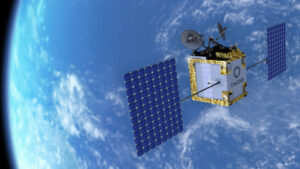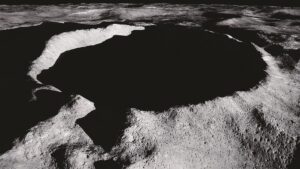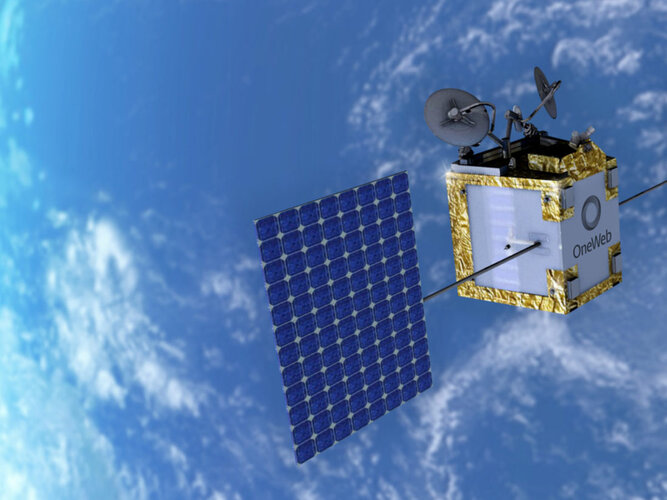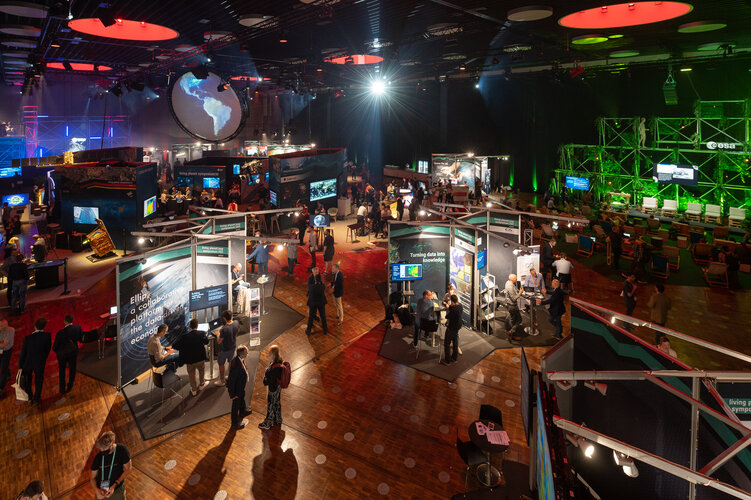The Philippines gives green light to Starlink
Friday, 27 May 2022 12:48
The Philippines has approved plans that will see it become the first country in Southeast Asia to access SpaceX’s Starlink broadband services.
The post The Philippines gives green light to Starlink appeared first on SpaceNews.
Astroscale gets funds for 2024 debris-removal mission
Friday, 27 May 2022 12:28
Astroscale has secured European Space Agency funding for a 2024 demo mission to remove what will likely be a OneWeb satellite.
The post Astroscale gets funds for 2024 debris-removal mission appeared first on SpaceNews.
Week in images: 23-27 May 2022
Friday, 27 May 2022 12:00
Week in images: 23-27 May 2022
Discover our week through the lens
China targets permanently shadowed regions at lunar south pole
Friday, 27 May 2022 11:41
China is looking to land spacecraft near permanently shadowed regions near the south pole of the moon to investigate the potential presence of resources trapped in craters.
The post China targets permanently shadowed regions at lunar south pole appeared first on SpaceNews.
Living Planet concludes with record numbers
Friday, 27 May 2022 10:42
With more than 5000 participants, 240 science sessions and over 1300 oral presentations, ESA’s Living Planet Symposium comes to a close with record-breaking numbers. Held on 23-27 May at the World Conference Center in the German city of Bonn, the symposium brought together world-class scientists, business leaders, representatives from space agencies and international organisations and industry from around the world. Throughout the week, they showcased the latest advances in Earth observation and highlighted the essential role of Earth observation for decision making regarding the ongoing climate crisis. As the week draws to a close, we look back
OneWeb, Astroscale, ESA and UK partner to launch space junk servicer ELSA-M
Friday, 27 May 2022 09:25 OneWeb together with Astroscale will seek to safeguard the satellite economy with ground-breaking new spacecraft technology, thanks in part to a new investment of 14.8 million euro. The mission to demonstrate Astroscale's ELSA-M servicer will launch towards the end of 2024, with ambitious plans to deliver a debris removal service to satellite operators thereafter.
The announcement builds u
OneWeb together with Astroscale will seek to safeguard the satellite economy with ground-breaking new spacecraft technology, thanks in part to a new investment of 14.8 million euro. The mission to demonstrate Astroscale's ELSA-M servicer will launch towards the end of 2024, with ambitious plans to deliver a debris removal service to satellite operators thereafter.
The announcement builds u GHGSat doubles capacity to monitor methane emissions with three new ABB-built optical sensors
Friday, 27 May 2022 09:25 Canadian company GHGSat, which specializes in high-resolution GHG monitoring from space, launches three new ABB-built optical sensors into space aboard a SpaceX Falcon 9 rocket from Cape Canaveral Space Force Station, doubling capacity to monitor methane gas emissions.
With ABB's technology, the GHGSat team is able to precisely locate and measure methane emissions from any given industrial
Canadian company GHGSat, which specializes in high-resolution GHG monitoring from space, launches three new ABB-built optical sensors into space aboard a SpaceX Falcon 9 rocket from Cape Canaveral Space Force Station, doubling capacity to monitor methane gas emissions.
With ABB's technology, the GHGSat team is able to precisely locate and measure methane emissions from any given industrial How the universe got its magnetic field
Friday, 27 May 2022 09:25 When we look out into space, all of the astrophysical objects that we see are embedded in magnetic fields. This is true not only in the neighborhood of stars and planets, but also in the deep space between galaxies and galactic clusters. These fields are weak - typically much weaker than those of a refrigerator magnet - but they are dynamically significant in the sense that they have profound ef
When we look out into space, all of the astrophysical objects that we see are embedded in magnetic fields. This is true not only in the neighborhood of stars and planets, but also in the deep space between galaxies and galactic clusters. These fields are weak - typically much weaker than those of a refrigerator magnet - but they are dynamically significant in the sense that they have profound ef Secure communication with light particles
Friday, 27 May 2022 09:25 The new system is used to exchange symmetric keys between parties in order to encrypt messages so that they cannot be read by third parties. In cooperation with Deutsche Telekom, the researchers led by physics professor Thomas Walther succeeded in operating a quantum network that is scalable in terms of the number of users and at the same time robust without the need for trusted nodes. In the fu
The new system is used to exchange symmetric keys between parties in order to encrypt messages so that they cannot be read by third parties. In cooperation with Deutsche Telekom, the researchers led by physics professor Thomas Walther succeeded in operating a quantum network that is scalable in terms of the number of users and at the same time robust without the need for trusted nodes. In the fu Kcell and SES demonstrate cellular network connectivity in Kazakhstan
Friday, 27 May 2022 09:25 Kcell, Kazakhstan's leading mobile network operator, and SES, the leading global content connectivity provider via satellite, have successfully demonstrated satellite-enabled cellular networks in remote parts of Kazakhstan. Kcell's terrestrial network was paired with SES's O3b satellites operating in medium earth orbit (MEO) to establish and test connectivity for 3G and 4G applications.
Du
Kcell, Kazakhstan's leading mobile network operator, and SES, the leading global content connectivity provider via satellite, have successfully demonstrated satellite-enabled cellular networks in remote parts of Kazakhstan. Kcell's terrestrial network was paired with SES's O3b satellites operating in medium earth orbit (MEO) to establish and test connectivity for 3G and 4G applications.
Du General Dynamics and Iridium awarded Ground Control and Operations Contract by SDA
Friday, 27 May 2022 09:25 General Dynamics Mission Systems (NYSE: GD) and Iridium Communications Inc. (NASDAQ: IRDM) have been jointly awarded a contract by the Space Development Agency in the amount of $324,516,613, including a base amount of $162,954,122 and $161,562,491 in options, to establish the ground Operations and Integration (O&I) segment for Tranche 1 of the National Defense Space Architecture (NDSA).
To
General Dynamics Mission Systems (NYSE: GD) and Iridium Communications Inc. (NASDAQ: IRDM) have been jointly awarded a contract by the Space Development Agency in the amount of $324,516,613, including a base amount of $162,954,122 and $161,562,491 in options, to establish the ground Operations and Integration (O&I) segment for Tranche 1 of the National Defense Space Architecture (NDSA).
To Sustainable connectivity in space
Friday, 27 May 2022 09:00
The world’s first mission to remove several small telecommunications satellites from orbit once they reach the end of their operational service is about to start building and testing its prototype spacecraft.
Boosting commercial Earth observation
Friday, 27 May 2022 08:45
One of the objectives of the Living Planet Symposium, taking place this week in Bonn, is to foster interaction between the institutional and commercial sectors to boost the Earth observation space economy. This is being achieved by highlighting existing partnerships, expanding the number of data users and facilitating access to private funds for companies.
Set off on your next adventure with the Paxi collection
Friday, 27 May 2022 06:10
Set off on your next adventure with the Paxi collection
Paxi: the perfect friend for young explorers!
Extraterrestrial civilizations may colonize the Galaxy even if they don't have starships
Friday, 27 May 2022 04:23 Astronomers have searched for extraterrestrial civilizations in planetary systems for sixty years, to no avail. In the paper published by International Journal of Astrobiology, Cambridge University Press, and titled "Migrating extraterrestrial civilizations and interstellar colonization: Implications for SETI and SETA," Irina K. Romanovskaya proposes that the search for extraterrestrial intellig
Astronomers have searched for extraterrestrial civilizations in planetary systems for sixty years, to no avail. In the paper published by International Journal of Astrobiology, Cambridge University Press, and titled "Migrating extraterrestrial civilizations and interstellar colonization: Implications for SETI and SETA," Irina K. Romanovskaya proposes that the search for extraterrestrial intellig 
